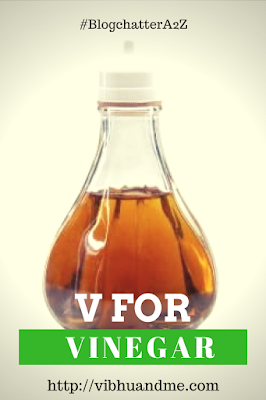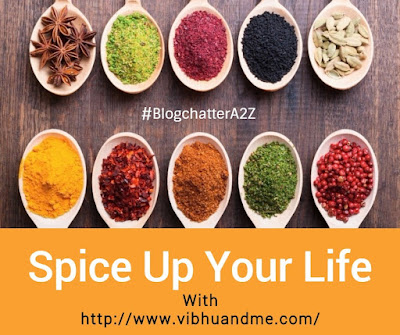During my childhood summer holidays, I used to go to my village. Living there for a whole month was like living a life free from pressure, worries, homework and even any kind of scolding. My Masi used to make pickles and Aam Papad. It was such fun seeing pickle making. My village in UP (Indian) during summers become a plaza for fruits like mangoes, jackfruits, cucumbers, and melons. And when the rain starts, there always happens an abundance of Jamun (Indian Blackberry). Kids enjoy these fruits in plenty and even get bored having them every day. And during the summer vacation only, Masi used to sieve the cane vinegar which was no less than an event for me as a kid. Yes, she used to prepare vinegar as well at home. My today's topic is also Vinegar which is a commonly found item in Indian kitchens.
V For Vinegar
Vinegar is a sour liquid that is prepared by fermenting alcoholic liquids. The name vinegar comes from a French naming, vin aigre, meaning sour wine. Since ages, vinegar has been made from materials including molasses, dates, sorghum, fruits, berries, melons, coconut, honey, beer, maple syrup, potatoes, beets, malt, and grains. No matter what the ingredient is, the principle remains unchanged; fermentation of natural sugars to alcohol and then secondary fermentation to vinegar. The acidic taste of vinegar makes it an ideal ingredient for cooking and for other household purposes. As a condiment and flavoring agent, it is used in pickles, chutneys, seasonings, dressings and many food items.
Although there are dozens of vinegars available in the market right from apple cider vinegar to white vinegar, I have always seen cane vinegar being used in my family. It is a dark brown liquid with a distinct pungent smell and sharp sour taste. Typically, sugarcane is crushed to extract the juice, simmered down into a syrup, and the syrup gets fermented into vinegar. However, I know the local process of making cane vinegar which is normally executed in villages of eastern UP.
Cane juice is put in big earthen pots covering their mouths with white cotton cloths during Jan and Feb. These pots are placed in a cool and dry place and it is not allowed to touch or open them for next few months. Then fermentation starts automatically and cotton cloths let fumes go out. After 4- 5 months, normally in June, these pots get opened and the syrup is filtered using a fresh cotton cloth only. The syrup is again collected in earthen pots or in glass bottles and they are put under the sun to stop any further contamination. After the exposure of sun for next couple of days, the vinegar is assumed ready for consumption. Everyone in my family like putting freshly made vinegar in our Dals and the sour taste of vinegar make dals even more delicious.
My mother-in-law also prepares flavored vinegar by adding raw mango, garlic, chilies, and jackfruit into the plain vinegar. Over the time, these things release their flavors in the vinegar and eventually, we get flavored vinegar and plus pickled mango, garlic, chilies, and jackfruit pieces. Believe me, they taste heavenly. My husband prefers vinegar over any readymade sauce and thus we savor our pakoras and chillas only with vinegar.
History of Vinegar
It is really amazing that in today’s computerized era, we are still using one thing that was discovered by chance more than 10,000 years ago. As its name says, (vin aigre - sour wine), somehow a cask of wine gone past its time and it eventually turned into a wonderful new product, vinegar. Babylonians used it as a preservative and as a condiment, and they only began flavoring vinegar with herbs and spices. Roman warrior used it as a beverage. The Greeks also made pickled vegetables or meats using vinegar. And references of Bible show that vinegar was much used for its soothing and healing properties. The first written history of vinegar in China dates to 1200 BC.
In 2,000 B.C., vinegar production became a commercial industry, before that it was made in houses only. During the American Civil War, vinegar was used to treat scurvy, and during World War I, it was being used to treat wounds. Throughout history, vinegar has proven to be the most versatile of products.
In India, when the vinegar making started is not clear but it is mentioned in ancient Ayurvedic and Sanskrit texts. Indians understood that vinegar can be made from almost anything which has sugar or starch, thus each area made vinegar from its local materials. In UP, it is made from sugarcane, in Bengal from Jamun, from coconut in the South, from jaggery in Calcutta and from raisins, palm, grapes, mahua flowers and toddy in other parts of India. You will be surprised to know that in 1948, licensees were required for vinegar manufacture as it involves making of alcohol during the process.
Ayurvedic Benefits of Vinegar
I don't know how but most people count the benefits of only apple cider vinegar. In fact, each of the natural vinegar comes with ample of benefits. Apple cider vinegar is known for its beauty benefits and weight loss blessing. Rice vinegar is known for improving heart health, liver health, and immunity in a person. Grape vinegar is a great painkiller and also good for the heart. And cane vinegar is a natural antiaging and antibacterial ingredient. Vinegar is full of anti-oxidants and is very beneficial for sugar control, blood pressure control and in the prevention of kidney stone. Other uses of vinegar are:
V For Vinegar
Vinegar is a sour liquid that is prepared by fermenting alcoholic liquids. The name vinegar comes from a French naming, vin aigre, meaning sour wine. Since ages, vinegar has been made from materials including molasses, dates, sorghum, fruits, berries, melons, coconut, honey, beer, maple syrup, potatoes, beets, malt, and grains. No matter what the ingredient is, the principle remains unchanged; fermentation of natural sugars to alcohol and then secondary fermentation to vinegar. The acidic taste of vinegar makes it an ideal ingredient for cooking and for other household purposes. As a condiment and flavoring agent, it is used in pickles, chutneys, seasonings, dressings and many food items.
Although there are dozens of vinegars available in the market right from apple cider vinegar to white vinegar, I have always seen cane vinegar being used in my family. It is a dark brown liquid with a distinct pungent smell and sharp sour taste. Typically, sugarcane is crushed to extract the juice, simmered down into a syrup, and the syrup gets fermented into vinegar. However, I know the local process of making cane vinegar which is normally executed in villages of eastern UP.
Cane juice is put in big earthen pots covering their mouths with white cotton cloths during Jan and Feb. These pots are placed in a cool and dry place and it is not allowed to touch or open them for next few months. Then fermentation starts automatically and cotton cloths let fumes go out. After 4- 5 months, normally in June, these pots get opened and the syrup is filtered using a fresh cotton cloth only. The syrup is again collected in earthen pots or in glass bottles and they are put under the sun to stop any further contamination. After the exposure of sun for next couple of days, the vinegar is assumed ready for consumption. Everyone in my family like putting freshly made vinegar in our Dals and the sour taste of vinegar make dals even more delicious.
My mother-in-law also prepares flavored vinegar by adding raw mango, garlic, chilies, and jackfruit into the plain vinegar. Over the time, these things release their flavors in the vinegar and eventually, we get flavored vinegar and plus pickled mango, garlic, chilies, and jackfruit pieces. Believe me, they taste heavenly. My husband prefers vinegar over any readymade sauce and thus we savor our pakoras and chillas only with vinegar.
History of Vinegar
It is really amazing that in today’s computerized era, we are still using one thing that was discovered by chance more than 10,000 years ago. As its name says, (vin aigre - sour wine), somehow a cask of wine gone past its time and it eventually turned into a wonderful new product, vinegar. Babylonians used it as a preservative and as a condiment, and they only began flavoring vinegar with herbs and spices. Roman warrior used it as a beverage. The Greeks also made pickled vegetables or meats using vinegar. And references of Bible show that vinegar was much used for its soothing and healing properties. The first written history of vinegar in China dates to 1200 BC.
In 2,000 B.C., vinegar production became a commercial industry, before that it was made in houses only. During the American Civil War, vinegar was used to treat scurvy, and during World War I, it was being used to treat wounds. Throughout history, vinegar has proven to be the most versatile of products.
In India, when the vinegar making started is not clear but it is mentioned in ancient Ayurvedic and Sanskrit texts. Indians understood that vinegar can be made from almost anything which has sugar or starch, thus each area made vinegar from its local materials. In UP, it is made from sugarcane, in Bengal from Jamun, from coconut in the South, from jaggery in Calcutta and from raisins, palm, grapes, mahua flowers and toddy in other parts of India. You will be surprised to know that in 1948, licensees were required for vinegar manufacture as it involves making of alcohol during the process.
Ayurvedic Benefits of Vinegar
I don't know how but most people count the benefits of only apple cider vinegar. In fact, each of the natural vinegar comes with ample of benefits. Apple cider vinegar is known for its beauty benefits and weight loss blessing. Rice vinegar is known for improving heart health, liver health, and immunity in a person. Grape vinegar is a great painkiller and also good for the heart. And cane vinegar is a natural antiaging and antibacterial ingredient. Vinegar is full of anti-oxidants and is very beneficial for sugar control, blood pressure control and in the prevention of kidney stone. Other uses of vinegar are:
- Helps to decrease food allergies.
- Reduces high alkalinity in blood.
- Helps to remove Dandruff, Itching Scalp & Hair loss.
- Good for Diabetes.
- Boosts Immunity.
- Good for healthy & glowing skin.
- Aids in reducing Hypertension.
- Helpful in controlling oral bacteria, which causes gum and oral diseases.
Dadi Maa Ka Nuskha
For natural conditioning of hair, after shampooing, do a final rinse with water mixed with a spoonful of vinegar.
How to buy
This is a tricky part. Although there are a variety of vinegars available in the market, I hardly believe in readymade vinegar. They could be synthetic and health hazardous too. So, buy a trusted brand and prefer local, nearby small industry made vinegar. They may not have fancy packaging but they will be better for consumption.
For natural conditioning of hair, after shampooing, do a final rinse with water mixed with a spoonful of vinegar.
How to buy
This is a tricky part. Although there are a variety of vinegars available in the market, I hardly believe in readymade vinegar. They could be synthetic and health hazardous too. So, buy a trusted brand and prefer local, nearby small industry made vinegar. They may not have fancy packaging but they will be better for consumption.
(I am taking part in #BlogchatterA2Z and today’s letter is 'V'.)
You can read my other #BlogchatterA2Z posts here :
You can read my other #BlogchatterA2Z posts here :
- A For Alkanet Root - A Magical Spice
- B For Black Salt - A Digestive Stimulant
- C For Cinnamon - God of Spices
- D for Dried Ginger - A More Beneficial Form of Ginger
- E For Edible Silver and Gold Foils
- F For Fennel Seeds - More Than A Mouth Freshener
- G for Green Cardamom - The Queen of Spices
- H For Holy Basil - The King of Herb
- I For Indian Gooseberry - A Super food
- J For Jaggery - A Medicinal Sugar
- K For Kalpasi - An Unknown Treasure
- L For Long Pepper - An Underrated Spice
- M For Mace - The Cousin of Nutmeg
- N For Nutmeg - The Pricey Spice
- O For Onion Seeds - The Flavor Master
- P For Poppy Seeds - The Nutty Savor
- Q For Quinoa And Quatre-Epices
- R For Red Chili - The Fierce Spice
- S For Star Anise - The Beautiful Spice
- T For Turmeric - The Golden Spice
- U For Urad Dal - A Great Tempering Ingredient












Wow ... I know so much about vinegar now. I had no idea that it can be made from different ingredients.
ReplyDeleteThe way you've described it being prepared in your village
and the many flavors it comes in - oh it made my mouth water. I so want to taste home made vinegar now.
https://lonelycanopyblog.wordpress.com/2018/04/24/vas-villa-bangalore-then-and-now/